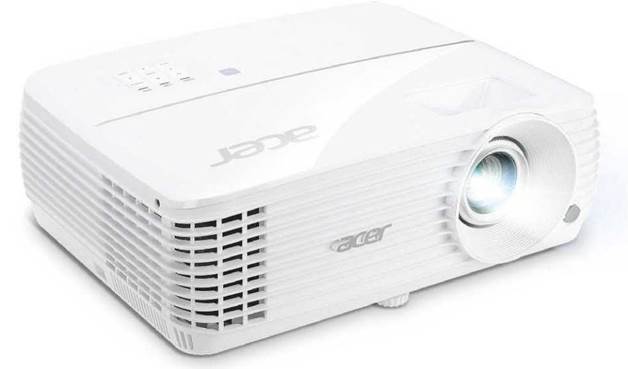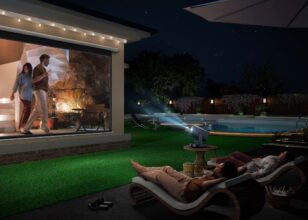Acer V6810 Review
Below the brand’s laser- and lamp-based 7 series models sits this affordable entry-level option
THE ACER V6810 kicks this group test off in style. First because it only costs ££££, and second because it’s really rather good. Not that its inner beauty is obvious from its exterior. The grilled side panels and cluttered top edge create a messy presence on your coffee table, despite the cute white finish.
Connections comprise two HDMIs (one with 4K HDR support), an RS-232 control port, a D-Sub PC port, audio input/output, a 12V trigger and a powered USB socket. These connections repeat in almost identical form right across this roundup.
As does the V6810’s use of single-chip DLP projection technology – currently the only method around to get 4K projection at a mass-market price. I must stress that the DLP approach doesn’t use a native 4K pixel count, instead ‘flashing’ each of its DLP mirrors repeatedly for every image frame to create what some would call only a virtual 4K pixel count. Yet images appear much more like 4K than HD, and the tech is certified as such by the Consumer Technology Association.
Optical zoom is limited to 1.2x and there’s no vertical image shifting. You may therefore need to use digital keystone correction to straighten the picture, even though this essentially distorts the image.
I settled on the V6810’s Movie preset as the best home cinema option, backed up by the ‘Low’ option of an unexpected ‘EOTF’ (Electro-Optical Transfer Function) feature.
This lets you select between three baseline HDR brightness settings. For me, Low delivers the richest colours and deepest blacks.
But the option is there if you’d rather watch generally brighter HDR pictures at the expense of some dynamic range.
The V6810 also lets you introduce colour, skin tone and sharpness enhancements. However, aside from maybe nudging the Super Resolution setting up a bit, the V6810’s pictures really don’t need any help.
Welcome to the jungle
Its colours, in particular, look superb. Rich tones in Jumanji: Welcome to the Jungle (Ultra HD Blu-ray), such as the greens of the jungle and the characters’ ‘abilities charts’, really pop. The brightest and darkest colour tones alike contain startling amounts of detailing and blending. Skin tones look both natural and largely free of blocking/striping issues.
The V6810’s so-called ColorPurity technology presumably contributes here.
This combines a ‘special’ colour wheel design with advanced lamp control to produce a wider colour gamut and enriched contrast.
This colour wheel prowess also restrains DLP’s rainbow effect, even over stand-out vivid picture elements such as the flickering torches lining the path to the Jaguar statue. And this sequence underlines the palpable difference even budget projectors can now deliver between SDR and HDR.
Despite producing the softest 4K pictures in this grouptest, the V6810 still shows that the single-chip DLP approach to 4K really works. Skin, hair and clothing minutiae on show are way beyond anything you’d see on an HD PJ.
There are areas where the V6810’s budget nature shows. First, in what will become a recurring theme, its black levels aren’t brilliant. There’s a noticeable grey pall over Jumanji’s night-time scenes, even though blacks are marginally better here than on the Acer’s roundup rivals. Rapid camera pans see the image look rather ragged, too, while the output of the built-in 10W speaker is uninspiring.
Let’s not finish on a downbeat note, though. Take the Acer V6810’s price into account, and the good far outweighs the bad.
SPECIFICATIONS
3D: No 4K: Yes. 3,840 x 2,160 HDR: Yes. HDR10 CONNECTIONS:2x HDMI inputs (one HDCP 2.2); D-Sub PC port; RS-232; powered USB; audio input/output; 12V trigger BRIGHTNESS (CLAIMED): 2,200 Lumens CONTRAST (CLAIMED): 10,000:1 ZOOM: 1.2x DIMENSIONS: 343(w) x 124.6(h) x 258(d)mm WEIGHT: 4kg
FEATURES: Single-chip DLP projector; 10W mono audio output; up to 15,000-hour claimed lamp life; EoTf setting options;
Acer ColorPurity technology







